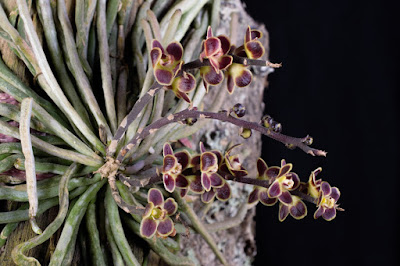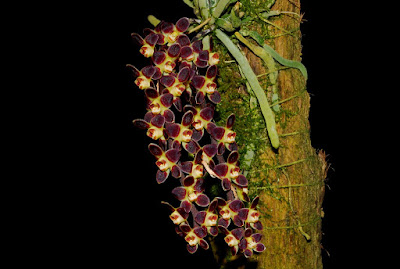Chiloschista lunifera is found in the eastern Himalayas, India, Assam, Myanmar, Thailand and Laos. Its natural habitat is semi-deciduous or deciduous forests, where it grows on trees at an altitude of 150-800 meters...
Chiloschista lunifera also called as The Moon Chiloschista, Chiloschista indica, Sarcochilus luniferus, Thrixspermum luniferum, is a species of the genus Chiloschista. This species was described by Johannes Jacobus Smith in 1905.
IDENTIFY CHILOSCHISTA LUNIFERA
Chiloschista lunifera is found in the eastern Himalayas, India, Assam, Myanmar, Thailand and Laos. Its natural habitat is semi-deciduous or deciduous forests, where it grows on trees at an altitude of 150-800 meters.
It is a small sized, leafless, hot to warm growing epiphyte with gray roots. Occasionally, in the period of active growth and with high levels of humidity, the plant can develop one or two small leaflets, which fall with the arrival of autumn.
The Moon Chiloschista blooms in the fall or winter on an erect, pubescent 7 to 30 cm long raceme arising from the mass of gray green roots with up to 20 fragrant flowers. The dark red flower are 1.5-2 cm in diameter.
CHILOSCHISTA LUNIFERA CARE AND CULTURE
Cultural information should only be used as a guide, and should be to be adapted to suit you. Your physical location; where you grow your plants, how much time you have to devote to their care, and many other factors, will need to be taken into account. Only then can you decide on the cultural methods that best suit you and your plants.
Light:
Chiloschista lunifera needs a light level of 16000-20000 lux. The plant must be protected from direct sunlight, as it may damage the root surface. The plant grows very well under artificial lighting. The ideal photoperiod is 12 hours, but in the rest period (November to March) it must be 10 hours.
Temperature:
From April to October, the plant needs 27-29 ° C and 20-21 ° C at night. In November, temperatures should gradually drop to 26-27 ° C during the day and 16-17 ° C at night. From December to February, daytime temperatures are 25-26 ° C during the day and 12-13 ° C at night. In March, daytime temperatures increase to summer levels, while nighttime temperatures always remain at 12-13 ° C.
Humidity:
During most of the year the air humidity must be 75-85%. Only during the rest of the rest period are the lowest levels acceptable: 60-65%.
Substrate, growing media and repotting:
Chiloschista lunifera is cultivated exclusively with bare roots, since the roots must be exposed to light to carry out photosynthesis. As a raft you choose a piece of wood as smooth as possible, because the roots of the orchid do not like irregular surfaces. Do not put me sphagnum under or above the roots. Despite the need for a good round of air, this orchid is not a species to be placed outdoors: the roots dry out too quickly and begin to lack moisture.
Watering:
The growing period in cultivation is characterized by hot and humid conditions, with frequent watering (up to 2 times a day) and nebulization (be careful to let the roots dry off after one watering and the other).
Fertilizer:
This species is fertilized only during the growth phase with 1/8 of the dose indicated on the bottle of a suitable liquid manure for orchids, adding it to the wetting water once a week.
Rest period:
The blooms of Chiloschista lunifera are mainly stimulated by the rest period. During the resting phase there is a slight lowering of diurnal temperatures and a drastic reduction of night-time temperatures. The wetting is reduced a lot; at the beginning of the rest the plants get wet once a day, but then only about once every 3-4 days. Air humidity must be 80% from November to January and drop to 60-65% from February to March. If the roots start to wrinkle, it is necessary to increase the frequency of wetting a little. In April the watering, temperatures and length of the photoperiod return to normal levels.

















COMMENTS